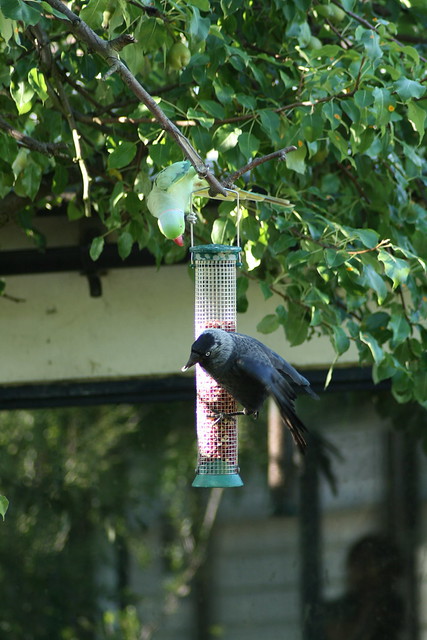 Ring-necked parakeet at its nest in AmsterdamWith the rise of the Ring-necked parakeet (Psittacula krameri) in the Netherlands the concerns about this alien invader increases. Birders in general are not much interested in introduced species. Ring-necked parakeets, Mandarin ducks (Aix galericulata), Hooded merganser (Lophodytes cucullatus) are persona non grata in the Dutch avifauna and they just do not count on your bird list.
Ring-necked parakeet at its nest in AmsterdamWith the rise of the Ring-necked parakeet (Psittacula krameri) in the Netherlands the concerns about this alien invader increases. Birders in general are not much interested in introduced species. Ring-necked parakeets, Mandarin ducks (Aix galericulata), Hooded merganser (Lophodytes cucullatus) are persona non grata in the Dutch avifauna and they just do not count on your bird list.
One might appreciate an individual bird but an alien invader is seen as a thread to native species. Just like misplaced rabbits in Australia the Ring-necks and other introduced species could become a plague in their newly conquered homelands.
In the case of the Ring-necked parakeet much attention is drawn to the fact that they are cavity breeding birds. They lay their eggs in a tree cavity, old woodpeckers nests for example. These cavities are relatively scarce. Trees need to mature before cavities like these form. A lot of native birds also depend on these scarce cavities. Birds like Woodpeckers, Starlings, Jackdaws, Tits and Nuthatches use them for breeding. Birders are reporting that birds compete over these cavities. Ring-necked parakeets are involved in these fights. Jackdaw and Ring-necked parakeet competing over resourcesThese reports were the incentive for biology student Willem van Esch to do a study on this phenomenon. The results were recently presented on his blog (in Dutch). Willem observed several nest sites of the Ring-necked parakeets in different parks in The Hague. He also looked into the history of the avifauna in these parks. His conclusion is: Ring-necked parakeets do not take over more nests from native birds than native birds take over nest form the parakeets. Even more important: they do not take over more nest cavities from native birds than native birds do among each other.
Jackdaw and Ring-necked parakeet competing over resourcesThese reports were the incentive for biology student Willem van Esch to do a study on this phenomenon. The results were recently presented on his blog (in Dutch). Willem observed several nest sites of the Ring-necked parakeets in different parks in The Hague. He also looked into the history of the avifauna in these parks. His conclusion is: Ring-necked parakeets do not take over more nests from native birds than native birds take over nest form the parakeets. Even more important: they do not take over more nest cavities from native birds than native birds do among each other.
Ring-necked parakeets prefer smaller cavities. Jackdaws on the contrary prefer larger cavities. The Parakeets response to intruders is fierce, nevertheless they more often than not lose these confrontations with native birds.
He also concludes that despite the increase of the parakeets there is no detectable decrease of native city park birds. The populations of native birds are stable. It should be stated though that the Jackdaw was the main competitor in city parks. Just a couple of Woodpeckers and one Nuthatch were found. His conclusions thus mostly apply on the interaction between Ring-necked parakeets and Jackdaws. He observed one confrontation between parakeets and a Woodpecker in which the Woodpecker won.
His research shows that despite the overlay in niches with other cavity breeders, the Ring-necked parakeet is no threat to jackdaws and most probably neither for Woodpeckers. When a confrontation arises the Ring-necked seems to lose out. Any effect on other cavity breeders can not be concluded from this study. In this perspective it is interesting to report that another naturalized parakeet, the Monk parakeet (Myiopsitta monachus), in Apeldoorn is losing their battle with Jackdaws. This parakeet, which uniquely build massive communal nests, is suffering because the Jackdaws keep squatting their nests and steel branches to build their own. The breeding results are so marginal that people fear they will become extinct there soon.